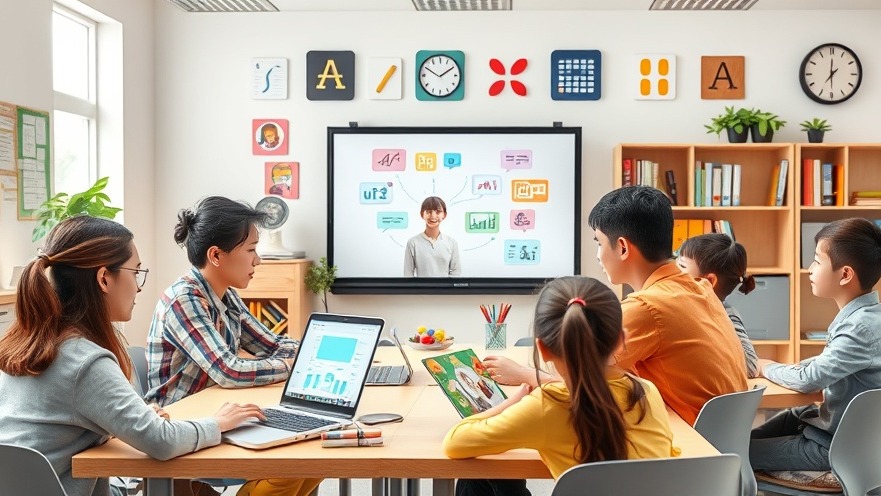
The Power of Google Forms: Streamlining Classroom Feedback
In today's fast-paced educational landscape, teachers are constantly seeking innovative ways to connect with their students and enhance learning experiences. Utilizing a tool as straightforward yet powerful as Google Forms can transform a teacher's ability to gather insights directly from students. As highlighted in the video Teachers, Try This: Utilize Google Forms for Routine Student ‘Vibe Checks’, incorporating these digital forms into daily routines not only promotes student engagement but also fosters a deeper understanding of their emotional and academic states.
In Teachers, Try This: Utilize Google Forms for Routine Student ‘Vibe Checks’, the discussion dives into effective methods for gathering student feedback, exploring key insights that sparked deeper analysis on our end.
Building a Cohesive System: Integration with Google Sheets
One of the most compelling benefits of Google Forms is its seamless integration with Google Sheets. Teachers can create a central digital planner that organizes various forms and data points into one accessible location. This integration allows for a swift overview of student feedback without the chaos of multiple applications. An educator in the video notes that she organizes all her classroom logs—from parent contacts to lesson feedback—within a singular Hub, simplifying classroom management tasks.
Emotional Well-Being Checks: The 'Wellness Wednesday' Approach
Another critical takeaway from the video is the concept of "Wellness Wednesday," a scheduled time when students fill out a feedback form regarding their emotional well-being. This not only promotes a culture of transparency regarding mental health but also aids teachers in recognizing patterns in student sentiments over time. For instance, if several students express confusion about a lesson, the teacher can address it promptly. This feedback loop is vital for creating a responsive learning environment and ensuring students feel seen and heard.
Increasing Student Engagement Through Anonymity
One significant advantage of using Google Forms for feedback is the level of anonymity it offers. Many students feel uneasy voicing concerns in front of peers. With Google Forms, they can freely express their thoughts, whether they enjoyed a lesson or struggled to grasp a concept, without fear of judgment. This anonymity can lead to more honest feedback, allowing teachers to adapt their methods or bring in additional resources that better cater to their class’s needs.
Data-Driven Teaching: Utilizing Student Feedback
The ability to collect and analyze data from Google Forms equips educators with actionable insights. The data can reveal trends, such as which lessons resonate most with students or highlight recurrent challenges. For instance, if a particular subject generates a series of low “understanding” scores, a teacher knows it’s time to revisit that material, possibly implementing different teaching strategies or supplemental resources. This proactive approach can significantly enhance overall classroom performance.
Action Steps for Teachers: Implementing Google Forms
For teachers interested in leveraging Google Forms effectively, start small. Begin with one or two regular forms—perhaps a weekly vibe check and a lesson feedback form. Over time, as comfort with the tool grows, teachers can expand the types of questions and frequency of surveys. By diversifying feedback methods and making data collection a habitual classroom practice, they can knock down the barriers to student engagement and understanding.
The Future of Teaching: Embracing Technology for Better Communication
The advent of technology in education has opened doors to enhancing teacher-student communication. As demonstrated in the video, utilizing tools like Google Forms can lead not only to improved data collection but also to a deeper connection between teachers and students. By trusting and empowering students to share their experiences candidly, educators help build a classroom environment that nurtures growth, creativity, and emotional well-being.
Teachers embarking on this journey can look to resources available online, from tutorials on designing effective forms to forums discussing best practices. Adapting to these new technologies not only aids individual educators but collectively enhances the academic experience.
In conclusion, as we navigate the complexities of modern education, integrating platforms like Google Forms into classroom practices is not just innovative but essential. By adopting these digital tools, teachers can elevate their engagement and responsiveness in the classroom, ultimately fostering a rich learning environment.
Call to Action: As educators explore new methodologies for engaging with students, incorporating Google Forms is a step toward modern teaching practices. Embrace technology in your classroom today and witness the difference in communication and student engagement.
 Add Row
Add Row  Add
Add 




 Add Row
Add Row  Add
Add 

Write A Comment